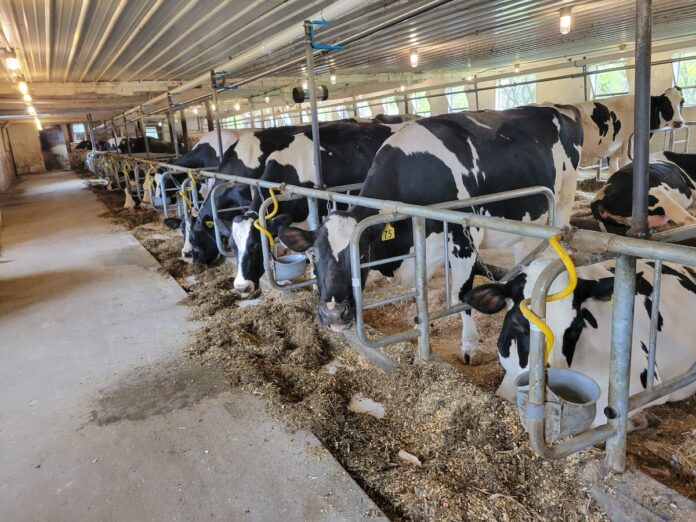
In dairy cattle, resumption of postpartum cyclicity is a normal process that takes place during the first 30 days in milk where cows ovulate and develop their corpus luteum. This is needed to re-establish the estrous cycle — every 21 days interval with range of 17 to 24 days — and pregnancy after parturition. Anestrous and anovulation are often used to define cyclicity and cystic cows. However, these ovarian conditions are often triggered by different causes. Let’s define the ovarian conditions.
Anestrus is defined as the failure of cows to exhibit obvious estrus —cow was not cycling — or because estrus was not detected — cow was cycling. Although failure to re-initiate cyclicity could be the root of the problem, this condition is more commonly associated with poor heat detection.
Animals showing short estrous cycles, poor cow comfort and dairy management decisions can all impact heat detection rate, which in turn could inaccurately determine that cows are anestrus when in fact they are not.
Anovulation is defined as the failure of cows to ovulate, in which cows often have abnormal follicular development and abnormal estrous cycles. Typically, this condition is observed in first lactation cows with excessive body weight loss early in lactation. It is important to note that this condition may or may not be associated with follicular cysts. Not all anovular cows are cystic, however, cystic cows are always anovular.
Ovarian cysts are follicle-like structure of greater than 25 millimeters in diameter that persist of the ovary. There are two types, follicular and luteal cysts. The proportion of postpartum cows with cysts at 26 or at 40 days in milk rage from 3 to 20%.
Troubleshooting
Several studies with multiple dairy herds have shown that as many as 25% or more of postpartum cows may not be cycling by the first 40-60 days in milk. When trouble-shooting poor cyclicity or cystic cows, the first step is to determine the ovarian conditions and magnitude of the problem because cystic cows fall under the same umbrella of anovular cows. Blood or milk progesterone tests as well as ultrasound screening of ovarian structures are very helpful to diagnose both conditions. Work with your veterinarian to accurately determine the proportion of anovular and cystic cows that occurs within the herd. The second step is to assess the potential underlying cause(s) focusing on factors you have control over.
Check the proportion of postpartum cows with metabolic (e.g., ketosis) and uterine health disorders (e.g. metritis). Following parturition, resumption of cyclicity within the first 30 days in milk largely depends on energy balance (higher blood NEFA concentrations before and after calving), the overall uterine health status and inflammation. The effect of parity, extended length of dry period — greater than 76 days — and season — heat stress during summer and increased calving rate during winter — are known risk factors.
Check your nutrition program to make sure cows are eating a balanced diet (e.g. energy, protein, minerals, vitamins) with normal range in MUN (8-14 milligrams per deciliter). Clean water troughs at least once per week.
Check for excessive body weight loss prepartum and within the first 20 days in milk (greater than 0.5 unit of BCS). Cows losing more than 62 pounds of body weight within the first 21 days of milking experience more cases of ketosis and metritis, which in turn reduced cyclicity by 22% and 31%, respectively.
Check potential contamination of mycotoxins in TMR for pre- and postpartum cows. This could trigger abortions, short gestations and interfere with ovarian structures causing reduced cyclicity.
Optimum dry matter intake is key for transition cow health because prepartum DMI determines postpartum DMI, thus, the overall energy balance status and resumption of cyclicity.
Non-dietary factors
The top three-non dietary factors affecting DMI are: 1) Poor cow comfort, 2) Linear feed bank (30 inches per cow) and water space (4 inches per cow with a flow of 10 Gallons per minute) and 3) Push-ups every 1 hour to ensure TMR is within reach of cows 22 out of 24 hours per day.
Is there a link between high milk yield cows and anovulation? There is no direct relationship between milk production and anovular conditions. Although high producing cows have increased liver clearance of reproductive hormones (e.g. estradiol and progesterone) associated with ovulation, research studies have not been able to find conclusive evidence that high milk yield increases anovulation.
Are there effective reproductive strategies? There are effective management strategies to help overcome the anovular and cystic conditions using reproductive protocols that combine prostaglandin, gonadotropin-releasing hormone and progesterone administration. Implementing a Presynch/Ovsynch, G-6-G, Double Ovsynch and Ovsynch with a CIDR insert protocol have all been shown to improve reproductive performance in anovular cows.
An ounce of prevention is worth a pound of cure! If anovulation or cystic cows are a concern in your herd, focus on factors you can control such as proper housing conditions and health program, providing proper nutrition and management to promote feeding behavior and having a reliable and well-trained group of workers who can properly handle the established protocols.
This will help you set animals up for a successful lactation and improved reproductive performance. Please have this discussion with your veterinarian and nutritionist. These little details make the difference at the end of the day.











